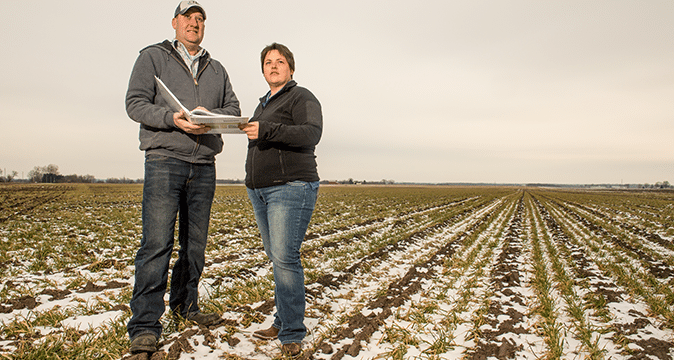A sixth-generation farmer, Maria Cox manages her southern Illinois farm alongside her father, Ethan. The 3,000-acre operation produces corn, soybeans, and corn silage. In addition, they manage 800 acres of hay, 750 head of cattle, and 100head cow/calf herd. Maria’s team has been no-tilling soybeans since 1988. Her future plans include no-tilling all soybean acres while no-tilling and strip-tilling corn acres, and incorporating cover crops into both management plans.
Maria started farming in 2012, the same year she and Kyle Lake, crop advisor with CHS Carrollton, started working together. Building on an existing 30-year Cox family and CHS Carrollton relationship, Maria and Kyle began formally implementing 4R Nutrient Stewardship practices. Combined with precision data they collect and analyze, yields are improving every year and the risk of potential nutrient losses are decreasing.
Extensive conservation practices complement the 4R protocols. These include dry dams, cover crops, transitioning to no-till, buffer strips around feedlots, grass waterways and buffer strips in fields, and participation in the Conservation Reserve Program to name a few. Work is paying off. Improved nutrient timing and placement yield $15,000 to $20,000 in annual savings. Variable-rate applications saved $5 to $10 per acre in the first year alone. Soil test levels are improving as well.
Best Practice Management
- Planted 25 percent of acres to cover crops in 2016 and 75 percent of acres in 2017.
- Use nitrogen stabilizer for liquid and dry fertilizers
- Use nitrogen inhibitor
- Use nitrification inhibitor to reduce in-field nitrogen loss
- Grid soil sampling
- Variable-rate nutrient application
- Account for nutrient credits from previous year
- Account for nutrient credits from cover crops to determine application rate
Implement fertigation on irrigated acres to apply nutrients to the most productive areas of the field - Use split application of nutrients so plants take them up more efficiently
- In-season plant tissue testing
- Foliar application of nutrients
- GPS-precision planting gets the right seed where it needs to go
- GPS-precision nutrient application avoids skips and saves on input costs
- GPS tillage
- Use satellite imaging to help identify yield potential and nutrient management plans
